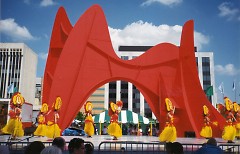A mall at 7:30 am on any day is usually the domain of security guards and mall walkers. Last Saturday, those habitually early risers were greeted by the rapid-fire sound of wood striking wood and the boom of a bass drum. While the Community Room at Centerpointe Mall is an unusual place to hear these sounds, it proved to be a perfect setting for a workshop on Tahitian drumming and dance.
When walking through the door, participants were greeted by Minnie Morey, the artistic director of the Pacific Island Dancers of Grand Rapids. The students, who came from as far away as Toronto and Wisconsin, walked past tables covered with leis, shells, and colorful clothing for sale. They then sat in a semi-circle facing a man holding up a hollowed-out log sitting next to a large two-headed bass drum. The log drum, called a toere in the Tahitian tradition is a surprisingly resonant drum that produces a wide variety of tones from sharp and loud to mellow and melodic. It is played with a heavy, pointed stick that looks more appropriate for slaying vampires than playing a drum.
For the next few hours this group of drummers and dancers were led through a sequence of progressively harder patterns using the toere by master instructor Kaili Francisco. Kaili has been teaching drumming using a notation system he developed over 30 years ago to preserve the traditional rhythms of Tahitian pehe or music. He is a director and performer for dance troops from Seattle to Waikiki. The soft-spoken teacher called out the names of the rhythms and then demonstrated playing the pahu, a two-headed bass drum made of sheet metal and originally covered with shark skin, with his left hand and the toere with his right hand. Using Kaili's notation we slowly learned to play the driving syncopated rhythms in preparation for the dance workshop in the afternoon.
After lunch, Kaili Francisco placed himself at the front of the room with his dancers on a stage next to him. With a loud shout, he started the rhythm at a blistering pace. The dancers began moving their hips at a steady rate that matched the beat of the pahu. The rows of brightly dressed dancers quickly weaved through each other moving their arms to the fast beat of the toere. As in other traditional forms, the dance closely follows the music becoming an extension of the forceful and intricate sounds. This spectacular combination of sound and movement is called the otea. The otea can be comprised of a dance in a single style, but more often it is a medley of traditional pieces each finished with a movement of tribute. This tribute belies the original intention of the otea. Currently used as performance in secular settings, the dance was used historically in ritual celebrations in the presence of tribal rulers.
The drummers and dancers who attended the workshop will take everything Francisco taught them back to their cities in preparation for a busy summer season ahead. With many shows booked already, the troops will perform the otea for festivals, wedding receptions, and parties throughout the country. With Francisco traveling to Washington D.C., Hawaii and Europe in the next couple of months, the traditional tahitian pehe we learned on that day at the mall will be played by troops around the world.
Pahu and Toere - Tahitian Drumming with Merahi O Tehani
Lokelani's Big Show 2009 - Element Otea
The Rapidian, a program of the 501(c)3 nonprofit Community Media Center, relies on the community’s support to help cover the cost of training reporters and publishing content.
We need your help.
If each of our readers and content creators who values this community platform help support its creation and maintenance, The Rapidian can continue to educate and facilitate a conversation around issues for years to come.
Please support The Rapidian and make a contribution today.

